JAPANESE FOLK MUSIC
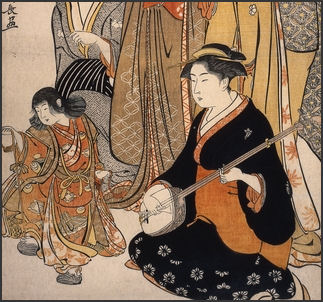
Japanese folk music (“min'yo”) falls into three categories according to the situation the songs are sung and the function of the song: (1) religious songs, such as the Shinto “ sato kagura “and the Buddhist Bon dance songs; (2) work songs such as rice-planting and boatmen’s songs; (3) occasional songs for parties, weddings, and funerals; and (4) children’s songs, including both traditional pieces (“ warabe uta”) passed down through the ages and songs (“ doyo”) written in the 20th century by noted poets and composers.”Rokyoku” (storytelling) and “ondo” (festival music) are also sometimes regarded as folk music.
“During the midsummer Bon festival, many Japanese, particularly in rural areas, dance and sing to local melodies played on “ shamisen”, flute, and drum to welcome the spirits of their ancestors, who are thought to return for a few days each year to the world of the living.
Classic Japanese songs that appeal to Westerners include Takio's “Soran Bushi”, Kubota Makoto's “Haisai Ojisan”, the Soul Flower's “Fukko Bushi and Mangetsu no Yube”. These songs are found on the “Rough Guide to the Music of Japan”.
A shovel playing competition — a Japanese take on the air guitar craze — is held in Goshogawara, Amori Prefecture. A record 177 people participated in the event in 2009. Bottle openers and spoons were among the objects used as picks.
Good Websites and Sources: Japanese Traditional Music. Columbia records site jtrad.columbia.jp ; Good Photos of Traditional Instruments at Japan-Photo Archive japan-photo.de ; Okinawan Music rca.open.ed.jp/web ; Barbara’s Enka Site technogirls.org/enka ; J-Fan Article on Enka j-fan.com ; Jero on Japan Probe japanprobe.com ; Philadelphia Japan Society article on Jero jasgp.org ; Taiko and Samisen Shamisen Page wsu.edu/~dee ; Kodo kodo.or.jp ; Nippon Taiko Foundation nippon-taiko.or.jp ; Rolling Thunder Taiko Resource taiko.com ; Eitetsu Hayashi eitetsu.net ; Kuni’s Web Site kuni-net.com Drums from Clan Yama Kaminari yamakaminari.com ;
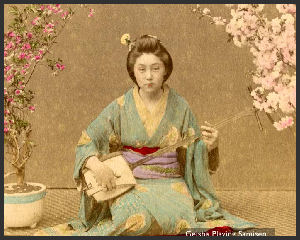
19th century geisha playing a samisen Links in this Website: CLASSICAL JAPANESE MUSIC Factsanddetails.com/Japan ; WESTERN CLASSICAL MUSIC IN JAPAN Factsanddetails.com/Japan ; JAPANESE FOLK MUSIC AND ENKA Factsanddetails.com/Japan ; J-POP AND POP MUSIC IN JAPAN Factsanddetails.com/Japan ; J-POP AND POP ARTISTS IN JAPAN Factsanddetails.com/Japan ; ROCK IN JAPAN Factsanddetails.com/Japan ; PUNK, FOREIGN MUSIC, HIP-HOP IN JAPAN Factsanddetails.com/Japan ; YOKO ONO Factsanddetails.com/Japan ; KARAOKE IN JAPAN Factsanddetails.com/Japan ; DANCE IN JAPAN Factsanddetails.com/Japan
Good Websites and Sources on Japanese Music: “The Rough Guide to the Music of Japan” is a CD assembled by Paul Fisher, Short Introduction to Japanese Music asnic.utexas.edu ; Bibliography on Music in Japan aboutjapan.japansociety.org ;Traditional Japanese Music and Dance sfusd.k12.ca.us/schwww ; Wikipedia article on Music of Japan Wikipedia ; Performing Arts Network of Japan performingarts.jp ; Traditional Performing Arts in Japan kanzaki.com ; Hear Music, a World Music Store with a hearjapan.com ; Japanese, Chinese and Korean CDs and DVDs at Yes Asia yesasia.com ; Japanese, Chinese and Korean CDs and DVDs at Zoom Movie zoommovie.com
Samisen

19th century samisen maker Introduced from Okinawa around the 16th century, the “samisen” (also spelled shamisen) is a three-stringed instrument with a long banjo-like neck, silk strings, long tuning pegs, and a squarish, soundboard made with taunt catskin or snakeskin on the front and dog skin on the back. Catskin or snakeskin produce the high-pitched twang associated with the instruments. Dogskin creates a lower, richer sound and rebounds the sound unlike catskin which generally absorbs it..
“The “ shamisen “was originally associated with the “ kabuki “and puppet theaters of the Edo period (1600-1868). A variation of the Okinawa three-stringed lute (“ sanshin”), shamisen “come in many different sizes, varying from 1.1 to 1.4 meters in length. When the “ shamisen “is played as an accompaniment to a singer, which is often the case, the fundamental pitch is set by the singer. Consequently, “ shamisen “notation indicates interval, or “ ma”, rather than pitch.
There are three kinds of samisen: 1) the common samisen; 2) the “Yanagawa-jamisen” (with a longer, thinner neck, used mainly in Kyoto); and 3) the “Tsugaru-jamisen” (the largest samisen, with a dogskin body). Instruments similar to the samisen include the “kohyu” (mainland Japan), Okinawan “kohyu” (Okinawa), “haegum” (South Korea), and “gidjak” (Uzbekistan).
Samisen Music
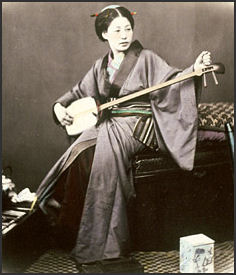
19th century samisen player Samisen is perhaps the most Japanese of all instruments. It was popularized in the 17th century by blind minstrels. Today, music from sour-faced samisen players accompanies Noh, kabuki and bunraku puppetry. Geisha have traditionally entertained their customers with samisen music.
Plucked with a large ivory pick that resembles a small ice scraper, the samisen has traditionally accompanied “joruri” (narrative pieces that emphasize lyrics over melody) and “naguata” (long epic songs concerned primarily with melody). Nagauta songs are performed by geisha and traditional samisen players. Samisen musical styles includes “kiyimoto, tokiwazu” and “shinnai”.
Some musicians play the samisen in the same position as a guitar. Others play it the traditional way with neck in a vertical position. When more than one samisen players play together the musicians often signal each other with grunts.
“Tsugaru-jamisen” players have tradition plucked out one rhythm on the neck while beating another on the instrument's body. The “tsugaru-jamisen” is associated with woeful, melancholy music of the snow country of Hokkaido and the Tsugaru region of Tohoku in northern Honshu and was developed about a hundred years ago to produce music that would carry farther. It is made out of durable dogskin to withstand the beating it takes.
Master Samisen Players
A master samisen player named Yahichi Takezawa told National Geographic that novices learning to play the samisen should ideally begin their training on June 6 when they are six-years old. "The samisen should only be played on sunny days," he also said. "Rain affects the tension of the instrument so that it does not sound so pure an honest." [Source: Charles McCarry, National Geographic, June 1976]
During 60 years of playing the samisen, Takezawa replaced his inch-thick pick every ten days and needed a new samisen every two months because his fingers wore away the wood on the neck. When he played live, Takezawa wore a sumo wrestler's girdle, he said, "so that the performance will not come only from the mind." When asked if he was going to retire Takezawa said, "I want to play until the day I die. In that way I will learn something on my last day, as I have on other day I have played the samisen."
The samisen player Tomoji Tsuruzawa has been designated a living national treasure and was stil playing at the of 94 in 2007. She told the Daily Yomiuri, “My dream is to make my music a visible entity, so listeners can “read” it. And to bring their tears to their my music is sad.” When she was a student Tsuruzawa practiced day and night and even gave up getting married for her craft. One of her students said her hands hurt for three years until she developed callused thick enough to stop the pain.
Popular Samisen Players
Popular samisen players include the Yoshida Brothers. They have produced albums that have sold more than 100,000 copies, which is a phenomenal number for a traditional music group. They are known for their showmanship, rock 'n roll haircuts and flashy dueling banjos style.
The Yoshida Brothers — Ryoichiro and Kenichi Yoshida — have been playing their instruments since the age of five. Their father wanted them to be professionals and forced to play in kneeling position for six hours at a time. At a young age they began winning contests in their native Hokkaido. After wowing audiences in a television appearances they were offered a recording contract and have not looked back since. Some have compared their playing with the guitar work of Jimi Hendrix.
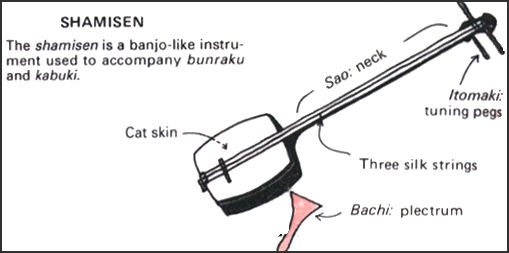
Hiromitsu Agatsuma is another popular young samisen player. Described as “shamisen player with a rock n’ roll attitude,” he has played with a rock band and appeared in Toyota commercial, playing his instrument on the beach at sunset. Shinichi Konoshita plays an electric samisen that he invented himself.
Takeharu Kunimoto uses his shamisen like a banjo to play bluegrass-style and even punk rock music. For a while he played in a band in Tennessee, where here he released a CD call “Appalachian Shamisen”.
Taiko
”Taiko” is a kind of traditional Japanese drumming often performed by sweaty, shouting, half-naked men in loincloths, who furiously bang “bachi” (thick sticks) on large wood-and-skin drums that are sometimes turned sideways and supported in the air on wooden frames. Taiko music is usually associated with festivals and large events.
Most taiko drums are made from hollowed out tree trunks with animal skin stretched over the head. Some are made with used wine barrels and skin pulled with tire jacks. Taiko ensembles sometimes also include “atarigane” (a bowl-shaped metal instrument struck with deer antlers), gongs of various sizes and occasionally bamboo flutes.
“Chosi Hane-daiko” is a style of drumming form Choshi, Chiba Prefecture in which a pair of drummers hold a drum between the sides of their bodies and beat it while leaping to the air. The performances can be very wild. When one of the pair falls to the ground for example, the other continues it beat the drum while lying in top of it.
The largest drum in the world is in Kita-Arita in northern Honshu. It is nearly four meter in diameter and four meters long and was originally used in rain-making rituals. Nobuo Nishioka, a professor of music anthropology at Osaka College of Music, told the Daly Yomiuri, “Four or five drummers beat each side and it is so heavy it has to be pulled by a tractor. The drums and other instruments were played originally for the gods.”
Book: “The Way of Taiko” by Heidi Varian (Stonebridge Press, 2006)
History of Taiko Drums
Taiko-style drums were introduced to Japan from China and Korea around the 5th century. Originally associated with Buddhism, the drums were used in gagaku music beginning in the 11th century, and over the years were incorporated into a variety of festivals and religious rites.
Rural taiko originally began as a way for silk worm producers to scare off birds and was used in religious observance to thank the gods for delivering the rice harvest.
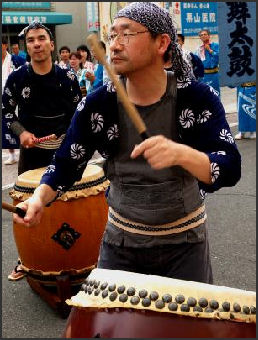
In the old days, the boundaries of rural communities was often defined by the distance which a taiko drum could be heard. People who could a hear a given drum were regarded as part of that community. They were also used in battles to signal soldiers and rouse them to fight.
The Japanese traditional drumming played by Kodo is known as “ wadaiko “ in Japan.Modern taiko is actually a post-World War II form of music formally known in Japan as “kumi-daiko” (group drumming). Explaining what it takes to be a good taiko drummer, one man told Natural History magazine, "You have to totally relax. Let the energy come from your “ki” [soul]. Feel the energy come from the mother earth, from the bottom of your feet...Screaming is very important! After you scream you feel good."
One member of Kodo told the Daily Yomiuri, "The movement is like a flow of electrons in an atom, the mixture of energies creates a circular motion — the cycle of life energy. The taiko drum is an unusual instrument because it’s round. The taiko creates a cyclic vibration. There is no beginning and no end, it enables you to be at one with the universe."
Taiko Groups
The two most well-known taiko ensembles are Kodo, a group that lives on a rural commune on the island of Sado in rural Japan; and Ondekoza, another Sado-Island-based ensemble that requires its drummers to exercise hard everyday.
Ondekoza was founded on Sado Island in 1970. Its name means "demon drum." Members were required by their leader, Den Tagayasu, to run marathons to build up strength and stamina and abstain from tobacco, alcohol and sex so their energy could be channeled into their music. The group once participated in the Boston Marathon.
Sado Island lies just of the coast of Niigata. It is known for its harsh winter, self-contained local culture and as a disposal point for vagrants, criminals and Korean slave laborers.
Eitetsu Hayashihas the unusual distinction of being one of the world's only solo taiko drummer. He played with Onekoza until 1982 when he decided to strike out on his own. He has worked with drummers from Guinea and South Korea and played with a didgeridoo player for Australia.
Kodo
Kodo was formed in 1981 to study, preserve and spread taiko music. It evolved from Ondekoza after Tagayasu left the group. In 1988, Kodo built their own village in Ogi, on the southern part of Sado, where their members still live to day in an environment regarded as close to nature and spirits. Outsiders can join the community but have apply for a “two-year apprenticeship," which requires total physical, mental and spiritual commitment.
Kodo is based in the "Kodomura village" on the Ogi Peninsula on the southern part of Sado Island. It takes about an hour by boat to get from Niigata Port to Ryotsu Port, the main entrance to the island. From there, it is a one-hour drive to the base. Kodomura village is outside densely populated areas and the surroundings are quiet. Twenty-five Kodo performers and apprentices live there. Takao Aoki, 55, a representative of Kodo who has labored to manage the group and direct its performances since its formation, hopes Kodo will deepen its relationship with local Sado residents. "We hope Kodo will bring out the charm of the island and become a local industry to attract tourists. For example, I want to make Sado an island of performing arts where small concerts with special features will be held regularly in every community."
Early History of Kodo and Kabuki Expression
In 1971, young performers from across the country gathered on the island and formed the troupe Sado no Kuni Ondeko-za. After 10 years of activity, the group was reformed under the name Kodo in 1981. That year, Kodo made its debut at the Berlin Festival in Germany, playing with a local orchestra. This performance raised the group's recognition in Japan and abroad. Since then, Kodo has created a whirlwind in the world of wadaiko, producing popular performers such as Eitetsu Hayashi and Leonard Eto. [Source: Junichiro Shiozaki, Yomiuri Shimbun, August 12, 2011]

Hitoshi Mogi, head of the variety entertainment engei division of the National Engei Hall in Tokyo, wrote a book called Nyumon Nihon no Taiko (introduction to Japanese drums). In it, the author said: "It was while abroad that Kodo first received recognition and was also recognized in Japan in the form of a reverse import. At a time when other taiko groups were struggling to break with the conventions of traditional performing arts, Kodo changed its style by focusing on music and brought out the novelty of wadaiko. The result was brilliant."
In 2000, Kodo asked kabuki actor Bando Tamasaburo to direct the group's performances. At that time, Kodo was struggling to shake off convention and broaden its scope of expression. Members who had seen Tamasaburo's profound stage performances invited the actor to the island to give them guidance.
At first, Kodo members were embarrassed by Tamasaburo's advice; but Kodo started practicing under Tamasaburo in 2001 and made performances directed by the actor in 2003 to a favorable reception. Kodo also participated in the Tamasaburo-directed play Amaterasu, which led to the creation of the concert Dadan (men who beat drums), performed in a novel style.
Tamasaburo expressed hope for Kodo's future, saying: "In order to become a true flower, not one that blooms only temporarily, Kodo should have a clear direction. To that end, it's important for the members to compete with each other and give higher-quality performances. If it wishes to perform for 100 years, Kodo mustn't fall into complacency and become self-contained. It's important that Kodo improve its performances so it can fully engage its audience. Kodo must add new elements while retaining the basics of wadaiko."
The kabuki actor added: "The art [of wadaiko] is very costly. I hope Kodo can establish a system by which it can perform well and earn money to spend on future performances; as a result, it will be able to give a spectacular show. The history of kabuki followed such a path from the Edo period [1603-1867]. I have a lot to pass on to young performers who devote their life to wadaiko."
Kodo Players
Yoshikazu Fujimoto, 60, is one of the original members of Kodo, which was formed in 1981. "I like taiko drums. It's my vocation to continue beating drums throughout my life," said Fujimoto, who is also the eldest member of the troupe. When Fujimoto was young, he tackled the taiko with stoic determination, building up his physique by running in marathons. He plans to beat drums until he is 80 years old. [Source: Junichiro Shiozaki, Yomiuri Shimbun, August 12, 2011]
"I'm not an artist, and I don't perform for the audience. By putting my heart and soul into playing, I'm trying to express Japanese people's spirituality. Even now, my life is a struggle," Fujimoto said.
Kenta Nakagome, 26, the youngest member of Kodo, joined the group in 2007. He started wadaiko when he was a primary school student, continued to study the traditional art in high school and later entered Kodo's taiko training center on Sado Island. The intensity with which Nakagome, with his enormous and powerful physique, beats the large drum has attracted attention. "I hope wadaiko will establish a solid place among the various performing arts," he said. "I want all people to recognize and appreciate Kodo, and not see it as passing fad."
Kodo consists of 12 to 14 members (including a couple of women). They spend about a third of their touring Japan, a third touring the world and third practicing and composing on Sado Island. Each year during the Earth Celebration they host musicians from all over the world. Kodo means "heartbeat,” "children of the drum” or children of the world."
On Sado the group combines arduous physical training and everyday life experiences. New York Times music critic James R. Oestreich wrote, “Despite this relative isolation, Kodo is public-spirited and internationally minded: thus the “one earth” notion, an extension of the idea that a community was once defined by the distance over which the o-daiko, the big drum used in Buddhist and Shinto temples, could be heard.” [Source: James R. Oestreich, New York Times, March 21, 2011]
Kodo performs original compositions written by the members and often inspired by nature. Most of the members play large taiko drums. One the largest drum is an ancient “mitsu tomoe”, which represents thunder. The drumming is sometimes accompanies by chanting, shouting encouragement, singing, flutes, small Buddhist-style cymbals bells, xylophones, maracas and gongs.
Kodo has played at Carnegie Hall in New York and the Acropolis in Athens. Mickey Hart of the Grateful Dead has produced one of their albums (“Mondo Head”). Kodo began by playing ritual music and have adapted their music over the years to please international audiences and incorporated music from Brazil, Tibet the United States and other places.
Kodo Performance
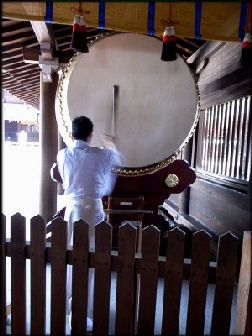
drum player Describing a Kodo performance, Paul Murray wrote in the Daily Yomiuri, The drummers began "with a slow repetitive beating of small snare drums and gradually increased in volume, tempo and intensity to a crescendo of perfectly executed, harmonious rhythm...Invisible communications joined them as the beat rose and fell in waves. Additional drums joined in, booming, thundering, beat rising, tension exploding and then...silence...The performers danced and drummed their way through the audience during the finale,” Murray wrote. “People were clapping, cheering and dancing in the aisle." Japanese fans often shout out “ganbatte” when they play to encourage them on to greater heights.
New York Times music critic James R. Oestreich called a typical Kodo evening in 2011: “a celebration of music, of physicality, of life. But it was delivered with a sort of manic intensity that spoke to the import of the moment more eloquently than any words could have...If you are to perform at all in this uninhibited, athletic style, you can only perform joyously and all-out.” [Source: James R. Oestreich, New York Times, March 21, 2011]
“The program — theatrically paced and lighted, and a bit slicker than those remembered from a decade or so ago — consisted mostly of Kodo standards, with a dance element added in the opening “ Sakaki,” composed by Masaru Tsuji and choreographed and executed by Kenzo Abe. The first half ended with Maki Ishii’s “ Monochrome,” in which a tapping on seven small drums little louder than a buzzing of insects swells into what a swarm of locusts must sound like, before subsiding and giving way to pounding on larger drums.”
“As always, the big drum came into play near the end, in the traditional “ O-Daiko.” Long the province of an elder master, Yoshikazu Fujimoto, the drum was played here by Kenta Nakagome, wielding clublike drumsticks over his head for what seemed an impossibly long time, and then some. The earth shook benignly. Then, as Mr. Fujimoto used to do, Mr. Nakagome threw himself into the final number, the traditional “ Yatai-Bayashi,” with scarcely a break...The encores were generous, in line with the overflowing spirit of the evening.”
Okinawan Music
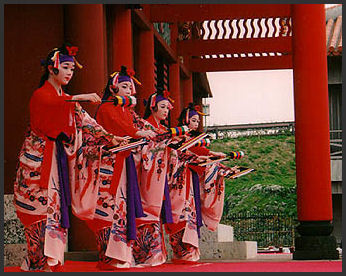
Okinawa festival Some people believe that the best Japanese music comes from Okinawa, which boasts massed “paranku” choruses of drummers, dancers and singers, and folk groups and popular artists who use modern instruments and traditional instruments like “sanshin” (a three-string Okinawan banjo that gave birth to the samisen). The classical Okinawan court music was not really for the audience's enjoyment. Minyo is popular Okinawan folk music.
Traditional Okinawan songs, known as shimauta (island songs), features taiko (drum), sanshin (a three-stringed instrument) and hayashi (call and response) singing. The ryuka style of Okinawan songs have 30 syllable verses’sets of eight, eight, eight and six."It's amazing how much meaning this style contains. I had to translate them before. But now I can listen and understand better,” one singer told the Yomiuri Shimbun. [Source: Hiroko Oikawa, Daily Yomiuri, October 14, 2011]
Okinawan “shima uta” ("music of the islands") grew out of traditional shaman rituals and varies somewhat from island to island. Amami island is said to have a particularly lively and fertile music scene. Rinsho Kadekarau is considered the "Godfather of Shima Uta." He died in 2000. Choki Fukuhara is considered the first major figure of modern “shima uta “. He founded Marafuku, Okinawa's most important local record label. His son Tsueno Fukuhara is one of Okinawa's most popular artists and important song writers.
The Hoptones are a male vocal quartet that have been a local institution since 1966. They do pop-style versions of Okinawan songs, many composed by Tsuneo Fukuhara. Yasukatsu Ohshima is highly regarded as the greatest vocalist of the older generation. Misako Oshiro is highly regarded as the best of the younger generation or traditional music.
Book: “The Power of Okinawa: Roots Music from the Ryukyus” by John Potter (KTO press)
Misako Oshiro and Kanako Horiuchi
Celebrated Okinawan minyo singer Misako Oshiro was born in Osaka and raised in Nago on Okinawa Island in a family where her grandfather and other family members were classical Okinawan musicians, Oshiro taught herself sanshin secretly. At the age of 20, she started studying classical Okinawan music, which stopped as soon as she was "drawn to minyo." "Women can be on stage as long as they learn the taiko. Originally, women didn't play the sanshin, but I didn't think that was right," Oshiro told the Yomiuri Shimbun.
Oshiro studied with Teihan China, the celebrated Okinawan musician and Sadao China's father. With her debut single "Kataumui" in 1962, she became a star with her "silky voice," performing across the country. Later Oshiro sang with legendary Okinawa minyo singer Rinsho Kadekaru, who called her his best duet partner. "Kadekaru would forget his lyrics and I had to help him," Oshiro recalled with a laugh.
While in her early career she was told just to sing, by the late 1970s women performing sanshin was no longer taboo. Oshiro's performances continued abroad and at home, while releasing albums Ichugui (silky voice) in 1997 and Utaumui in 2007 to mark 50 years of performing. "Singing is like 'katari' [dialog]. It's about reaching the audience with a message. Without that, it's meaningless," Oshiro said.
Kanako Horiuchi, a young woman from Hakodate, Hokkaido and student of Oshiro, received the Ryukyu Ongaku Kyokai's (Ryukyu music association) best young musician award and in 2007 won the best performer award at a Ryukyu Ongaku Kyokai competition. Horiuchi's activities have included performing in Oshiro's 2002 tour to Paris and her own world tour in 2009.
Okinawan Pop Musicians
Sadao China established the trend in the 1970s of mixing Okinawan music with Western forms such as reggae. He recorded the well-received alum “Koza Dahasa” with Ry Cooder on slide guitar, David Hildago on accordion and Jim Keltner on drums. Shoukichi Kina also blended Western and Okinawan styles and worked with Ry Cooder as well as Haroumi Hosono.
The Rinken Band is one Okinawa's most popular and critically acclaimed groups. Founded in 1977, the group blends pop music and traditional Okinawan instruments and have helped revive the traditional music of the Ryuku islands. They have record 11 CDs. Their first hit, Arigato (1985) was followed by a string of hits in Japan.
The Rinken band is named after its founder Teruya Rinken. The group has eight members, including singer Tomoko Uehara (Rinken's wife), a samisen player, and a samba player and powerful rhythm section. In their live shows they appear in colorful costumes and perform traditional eisa dancing.
Other highly-regarded Okinawan artists include Begin, Champloose, and Nenez.
Chitose Hajime
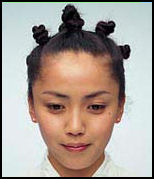
Chitose Hajime was the first traditional-style Okinawan singer to make it big in the J-pop scene. Born and raised on Amamo Oshima, between Kyushu and Okinawa, she uses reggae and J-pop as vehicle to sing in a quivering style characteristic of female singers from the Okinawa area.
Hajime was one of the most happening singers in the 2002 and 2003. Her records sold in the millions and her concerts sold out. Unlike many Okinawan singers she does not come from a musical family. She comes from a village with only 50 people. In her elementary school there were only four students, including herself. She developed an interest in traditional music after studying the shamisen at age 11 in school and later learned to sing in shimautu.
Hajime originally wanted to be a hairdresser but turned to singing when she discovered that chemicals used in perms and dying hair gave her asthma. Her voice is so haunting and beautiful, with a kind of fluttering falsetto, that some give her a chance of becoming big outside of Japan. She has performed with the French New Age band Deep Forest.
Image Sources: 1) British Museum 2) 4) 5) 6) Visualizing Culture, MIT Education 3) JNTO4) 7), 8) Ray Kinnane 9) Libaray of Congress, 10, 11), 12) 13) Japan Zone
Text Sources: New York Times, Washington Post, Los Angeles Times, Daily Yomiuri, Times of London, Japan National Tourist Organization (JNTO), National Geographic, The New Yorker, Time, Newsweek, Reuters, AP, Lonely Planet Guides, Compton’s Encyclopedia and various books and other publications.
Last updated August 2012
